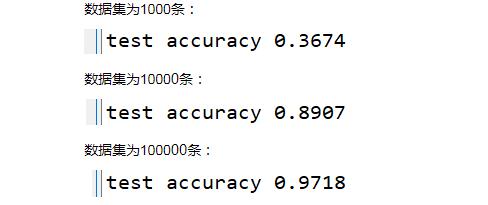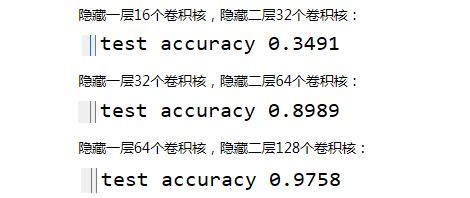

卷积神经网络三大特点_卷积神经网络代码实现
电子说
描述
卷积神经网络三大特点
1.局部连接,局部连接会大大减少网络的参数。在处理图像这样的高维度输入时,让每个神经元都与前一层中的所有神经元进行全连接是不现实的。让每个神经元只与输入数据的一个局部区域连接,该连接的空间大小叫做神经元的感受野,它的尺寸是一个超参数,其实就是滤波器的空间尺寸。
2.权值共享,在卷积层中使用参数共享是用来控制参数的数量。每个滤波器与上一层局部连接,同时每个滤波器的所有局部连接都使用同样的参数,此举会同样大大减少网络的参数。
3.空间或时间上的下采样,它的作用是逐渐降低数据的空间尺寸,这样的话就能减少网络中参数的数量,使得计算资源耗费变少,也能有效控制过拟合。
卷积神经网络代码实现
卷积神经网络【Convolutional Neural Networks,CNN】是一类包含卷积计算且具有深度结构的前馈神经网络【Feedforward Neural Networks】是深度学习的代表算法之一。卷积神经网络具有表征学习【representation learning】能力,能够按其阶层结构对输入信息进行平移不变分类。
神经网络实质上是多层函数嵌套形成的数学模型。1998年Yann LeCun等人推出了LeNet-5架构,广泛用于手写字体识别,包含全连接层和sigmoid激活函数,还有卷积层和池化层。
1 # -*- coding: utf-8 -*-
2 “”“
3 Created on Wed Nov 21 17:32:28 2018
4
5 @author: zhen
6 ”“”
7
8 import tensorflow as tf
9 from tensorflow.examples.tutorials.mnist import input_data
10
11 mnist = input_data.read_data_sets(‘C:/Users/zhen/MNIST_data_bak/’, one_hot=True)
12 sess = tf.InteractiveSession()
13
14 def weight_variable(shape):
15 initial = tf.truncated_normal(shape, stddev=0.1)
16 return tf.Variable(initial)
17
18 def bias_variable(shape):
19 initial = tf.constant(0.1, shape=shape)
20 return tf.Variable(initial)
21
22 def conv2d(x, W):
23 return tf.nn.conv2d(x, W, strides=[1, 1, 1, 1], padding=‘SAME’)
24
25 def max_pool_2x2(x):
26 return tf.nn.max_pool(x, ksize=[1, 2, 2, 1], strides=[1, 2, 2, 1], padding=‘SAME’)
27
28 x = tf.placeholder(tf.float32, [None, 784])
29 y = tf.placeholder(tf.float32, [None, 10])
30 x_image = tf.reshape(x, [-1, 28, 28, 1])
31
32 # 第一层卷积核
33 W_conv = weight_variable([5, 5, 1, 16])
34 b_conv = bias_variable([16])
35 h_conv = tf.nn.relu(conv2d(x_image, W_conv) + b_conv)
36 h_pool = max_pool_2x2(h_conv)
37
38 # 第二层卷积核
39 W_conv2 = weight_variable([5, 5, 16, 32])
40 b_conv2 = bias_variable([32])
41 h_conv2 = tf.nn.relu(conv2d(h_pool, W_conv2) + b_conv2)
42 h_pool2 = max_pool_2x2(h_conv2)
43
44 # 全连接层
45 W_fc = weight_variable([7 * 7 * 32, 512])
46 b_fc = bias_variable([512])
47 h_pool_flat = tf.reshape(h_pool2, [-1, 7 * 7 * 32])
48 h_fc = tf.nn.relu(tf.matmul(h_pool_flat, W_fc) + b_fc)
49
50 # 防止过拟合,使用Dropout层
51 keep_prob = tf.placeholder(tf.float32)
52 h_fc_drop = tf.nn.dropout(h_fc, keep_prob)
53
54 # Softmax分类
55 W_fc2 = weight_variable([512, 10])
56 b_fc2 = bias_variable([10])
57 y_conv = tf.nn.softmax(tf.matmul(h_fc_drop, W_fc2) + b_fc2)
58
59 # 定义损失函数
60 cross_entropy = tf.reduce_mean(-tf.reduce_sum(y * tf.log(y_conv), reduction_indices=[1]))
61 train_step = tf.train.AdamOptimizer(1e-4).minimize(cross_entropy)
62 correct_prediction = tf.equal(tf.argmax(y_conv, 1), tf.argmax(y, 1))
63 accuracy = tf.reduce_mean(tf.cast(correct_prediction, tf.float32))
64
65 # 训练
66 tf.global_variables_initializer().run()
67 for i in range(20):
68 batch = mnist.train.next_batch(50)
69 train_step.run(feed_dict={x:batch[0], y:batch[1], keep_prob:0.5})
70
71 print(“test accuracy %g” % accuracy.eval(feed_dict={x:mnist.test.images, y:mnist.test.labels, keep_prob:1.0}))
结果:
1.算法模型不变,增大训练集数据【隐藏一层16个卷积核,隐藏二层32个卷积核,全连接层512,10分类】:

2.训练集数据不变,增大卷积核数【数据集为10000,全连接层512,10分类】:

责任编辑:YYX
-
卷积神经网络的原理与实现2024-07-02 1684
-
卷积神经网络概述 卷积神经网络的特点 cnn卷积神经网络的优点2023-08-21 4255
-
卷积神经网络原理:卷积神经网络模型和卷积神经网络算法2023-08-17 2150
-
卷积神经网络模型发展及应用2022-08-02 13201
-
卷积神经网络一维卷积的处理过程2021-12-23 1776
-
卷积神经网络的层级结构和常用框架2020-12-29 2779
-
卷积神经网络的优点是什么2020-05-05 3527
-
什么是图卷积神经网络?2019-08-20 2313
-
卷积神经网络如何使用2019-07-17 2726
-
全连接神经网络和卷积神经网络有什么区别2019-06-06 5906
全部0条评论

快来发表一下你的评论吧 !

